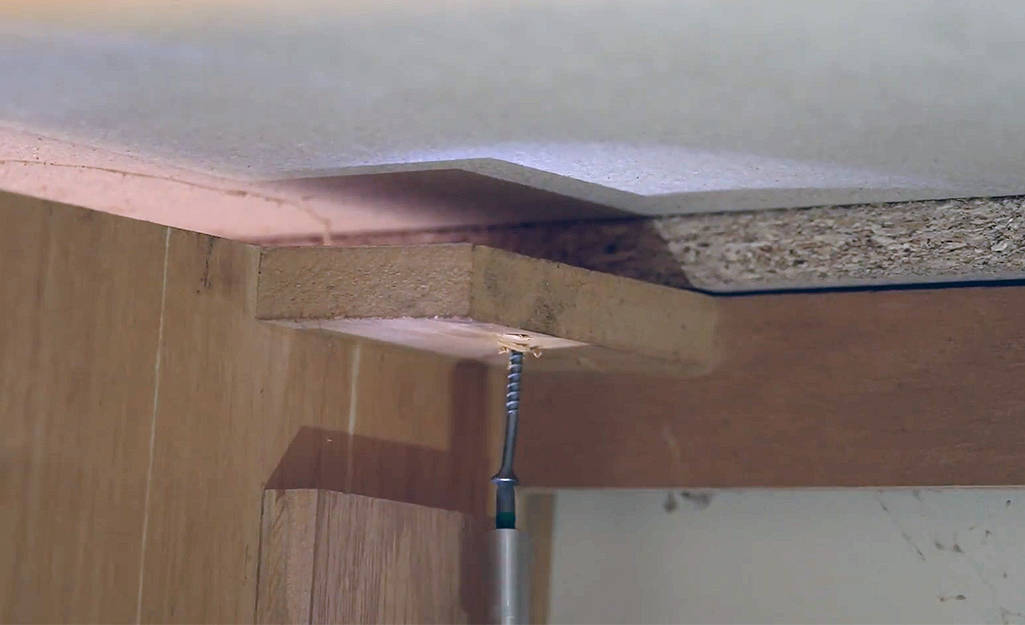Understanding Countertop Installation Methods
:no_upscale()/cdn.vox-cdn.com/uploads/chorus_asset/file/19495296/counter_top_illo.jpg)
Installing countertops involves securely attaching them to cabinets, creating a functional and aesthetically pleasing work surface. There are several methods commonly used, each with its own advantages and considerations.
Screws and Brackets
Screws and brackets provide a robust and reliable method for attaching countertops to cabinets. This method is particularly suitable for heavier countertop materials, such as granite, marble, and engineered stone.
- The process typically involves drilling pilot holes into the countertop and cabinet, then securing brackets to the underside of the countertop using screws.
- The brackets are then attached to the cabinet with screws, ensuring the countertop is securely fastened in place.
The spacing of screws and brackets should be determined based on the size and weight of the countertop, as well as the type of cabinet construction.
Clamps and Adhesives
Clamps and adhesives offer a flexible and less invasive approach to countertop installation. This method is often used for lighter materials, such as laminate or solid surface countertops.
- The countertop is placed on the cabinets and held in position using clamps while the adhesive sets.
- Adhesives specifically designed for countertop installation provide strong bonding and create a durable seal.
The clamping time will vary depending on the type of adhesive used, and it is crucial to follow the manufacturer’s instructions for proper setting time.
Custom Fabrication
Custom fabrication involves creating countertops that are specifically tailored to the dimensions and design of the cabinets. This method offers a high degree of customization and allows for unique shapes and sizes.
- The countertop is typically fabricated using materials such as granite, marble, quartz, or engineered stone.
- The fabrication process may involve cutting, shaping, and polishing the countertop to meet the specific requirements.
- Once fabricated, the countertop is attached to the cabinets using a combination of screws, brackets, and adhesives, depending on the material and design.
Custom fabrication is often preferred for high-end kitchens or projects with unique design requirements.
Choosing the Right Installation Method
Selecting the appropriate installation method depends on several factors:
- Countertop Material: Heavier materials like granite or marble often require screws and brackets for secure support, while lighter materials like laminate may be suitable for adhesive-based installation.
- Cabinet Construction: The strength and stability of the cabinets will influence the installation method. Cabinets with solid frames and sturdy construction can accommodate heavier countertops, while those with lighter frames may require a more flexible approach.
- Desired Aesthetics: The chosen installation method can impact the overall appearance of the countertop. Screws and brackets may be visible, while adhesive-based installations provide a seamless finish.
Common Countertop Materials and Installation Compatibility, How do countertops attached to cabinets
| Countertop Material | Installation Method |
|---|---|
| Granite | Screws and Brackets, Custom Fabrication |
| Marble | Screws and Brackets, Custom Fabrication |
| Quartz | Screws and Brackets, Custom Fabrication, Clamps and Adhesives |
| Engineered Stone | Screws and Brackets, Custom Fabrication, Clamps and Adhesives |
| Laminate | Clamps and Adhesives |
| Solid Surface | Clamps and Adhesives |
Step-by-Step Guide to Countertop Installation: How Do Countertops Attached To Cabinets

Installing countertops is a significant step in any kitchen or bathroom renovation project. It involves precision cutting, careful fitting, and secure attachment to create a functional and visually appealing surface. This guide will walk you through the entire process, from preparation to finishing touches, to ensure a successful countertop installation.
Preparation
Before starting the installation, it’s crucial to ensure that the cabinets are properly prepared. This involves leveling, cleaning, and ensuring that the cabinet surface is ready to receive the countertop. Additionally, the countertop itself should be inspected for any damage or defects.
- Leveling the Cabinets: Using a level, ensure that the cabinets are level in both directions. Any unevenness can lead to a misaligned countertop and compromise its stability. Adjust the cabinet feet or shims as needed to achieve a perfectly level surface.
- Cleaning the Cabinets: Thoroughly clean the cabinet tops to remove any dust, debris, or residue. This will ensure a strong bond between the countertop and the cabinets.
- Inspecting the Countertop: Before installation, inspect the countertop for any chips, cracks, or other imperfections. If any defects are found, address them before proceeding.
Cutting and Fitting
The countertop needs to be precisely cut and fitted to the cabinet dimensions. This step requires careful measurements and accurate cutting to ensure a seamless fit.
- Measuring the Cabinets: Take accurate measurements of the cabinet openings, including any curves or angles. It’s best to measure multiple times to avoid errors.
- Cutting the Countertop: Using a specialized countertop saw, cut the countertop to the required dimensions. Make sure to leave a slight overhang for the backsplash, if applicable.
- Fitting the Countertop: After cutting, fit the countertop to the cabinets. Adjust the fit as needed using a router or other tools to ensure a snug and precise fit.
Securing the Countertop
Once the countertop is fitted, it needs to be securely attached to the cabinets. The method of attachment depends on the type of countertop material and the chosen installation method.
- Using Adhesive: For some countertop materials, a strong adhesive can be used to bond the countertop to the cabinets. This method is typically used for lighter materials, such as laminate or solid surface countertops.
- Using Clips or Brackets: Clips or brackets can be used to secure the countertop to the cabinets, especially for heavier materials like granite or quartz. These clips or brackets are typically attached to the underside of the countertop and secured to the cabinets.
- Using Screws or Bolts: For some countertop installations, screws or bolts can be used to attach the countertop to the cabinets. This method is often used for countertops with a built-in overhang or for situations where extra support is needed.
Finishing Touches
After the countertop is secured, it’s time to add the finishing touches. This includes sealing the edges, applying caulk, and completing the installation.
- Sealing the Edges: For porous countertop materials like granite or marble, sealing the edges is essential to protect them from stains and moisture. Use a sealant specifically designed for the countertop material.
- Applying Caulk: Caulk is used to fill any gaps between the countertop and the backsplash or the wall. Choose a caulk that matches the countertop color and apply it neatly using a caulk gun.
- Cleaning Up: After the installation is complete, clean up any excess adhesive, caulk, or dust.
Essential Tools and Materials

Having a countertop installed is a major project, and having the right tools and materials can make the process smoother and more successful. The tools and materials required will depend on the type of countertop you’re installing, the size and complexity of the project, and the installation method.
Tools
The tools needed for countertop installation can be grouped into different categories based on their function. Here’s a list of essential tools, along with their purpose and usage:
- Circular Saw: A circular saw is used to cut large pieces of countertop material to size. It’s crucial to use a blade specifically designed for the material you’re working with, such as stone or laminate.
- Jigsaw: A jigsaw is useful for making intricate cuts, such as those required for sink openings or for fitting the countertop around corners. It’s often used in conjunction with a template to ensure accurate cuts.
- Measuring Tape: A measuring tape is essential for accurately measuring the countertop and the space it will occupy. Make sure you have a tape measure that is at least 25 feet long, as countertops can be quite large.
- Level: A level is used to ensure that the countertop is installed at a perfectly horizontal and even level. This is crucial for both aesthetic and functional reasons.
- Drill: A drill is used to create pilot holes for screws and to install fasteners. A cordless drill with a variety of bits is ideal for countertop installation.
- Screwdriver: A screwdriver is used to tighten screws and other fasteners. It’s helpful to have a set of screwdrivers with different sizes and tip types.
Materials
The materials used in countertop installation play a vital role in securing the countertop to the cabinets and ensuring a long-lasting and durable installation. Here’s a breakdown of essential materials:
- Screws: Screws are used to attach the countertop to the cabinets. The type and size of screws will depend on the material of the countertop and the cabinets. It’s important to choose screws that are long enough to penetrate through the countertop and into the cabinet frame, providing secure fastening.
- Brackets: Brackets, also known as countertop supports, are used to provide additional support for the countertop, especially for large overhangs. These brackets are typically made of metal and are attached to the cabinet frame and the underside of the countertop.
- Adhesive: Adhesive is used to bond the countertop to the cabinets, creating a strong and durable bond. The type of adhesive used will depend on the material of the countertop. For example, construction adhesive is commonly used for laminate countertops, while epoxy adhesive is often used for natural stone countertops.
- Caulk: Caulk is used to seal the gaps between the countertop and the backsplash, sink, and other fixtures, preventing water damage and creating a clean and finished look.
- Sealant: Sealant is used to protect the countertop from stains and water damage. The type of sealant used will depend on the material of the countertop. For example, a penetrating sealant is commonly used for natural stone countertops, while a topical sealant is often used for laminate countertops.
Choosing the Right Tools and Materials
Choosing the right tools and materials for your countertop installation is essential for a successful project. Here are some tips:
- Countertop Material: The type of countertop material will determine the tools and materials you need. For example, a circular saw is essential for cutting laminate countertops, while a diamond-tipped blade is needed for cutting natural stone countertops.
- Installation Method: The installation method will also influence the tools and materials required. For example, if you’re using a template for installation, you’ll need a jigsaw to cut the countertop to shape.
- Project Complexity: The size and complexity of the project will also determine the tools and materials needed. For example, a larger project may require additional support brackets and adhesive.
- Budget: It’s important to consider your budget when choosing tools and materials. While some tools and materials are essential, there are also more affordable alternatives available.
How do countertops attached to cabinets – The seemingly simple process of attaching countertops to cabinets is often riddled with complexities, one of the most common being the dreaded “gap” that can appear between the countertop and the base cabinet. This unsightly gap, a testament to poor craftsmanship or a lack of attention to detail, can be a real eyesore.
Thankfully, there are ways to minimize or even eliminate this gap, as outlined in this comprehensive guide: gap between countertop and base cabinet. Ultimately, the success of countertop installation hinges on meticulous planning and execution, ensuring a seamless and aesthetically pleasing finish that elevates the overall look of the kitchen.
The intricacies of attaching countertops to cabinets are a microcosm of the larger, more insidious issue of how we define “luxury” in our homes. While we obsess over the latest trends, like a master bedroom feature wall , the fundamentals of solid construction are often overlooked.
Perhaps if we spent less time chasing fleeting trends and more time focusing on the quality of materials and craftsmanship, we’d end up with spaces that truly stand the test of time.
